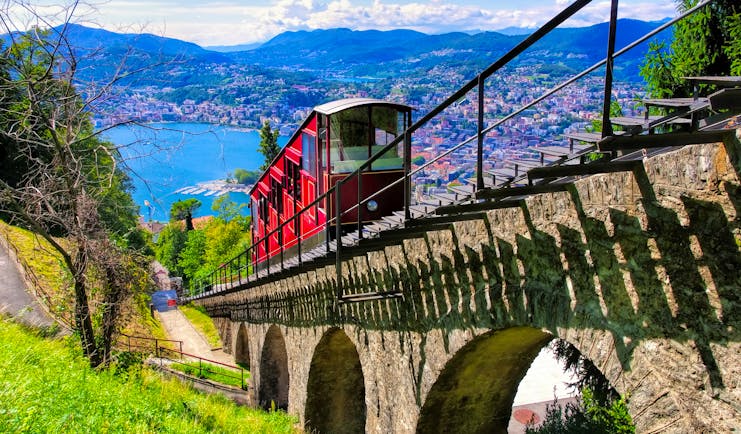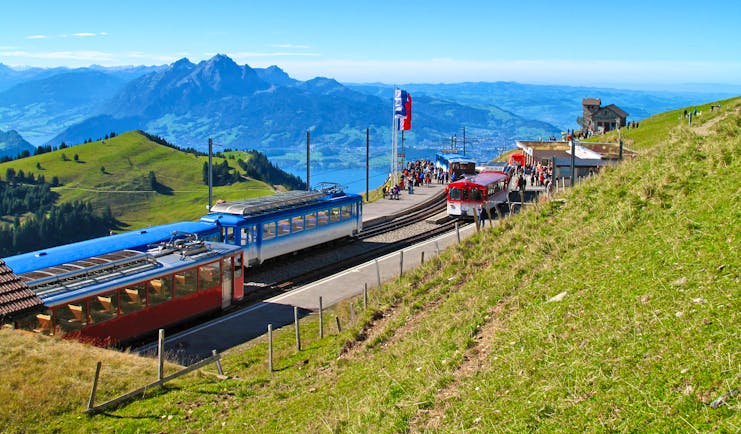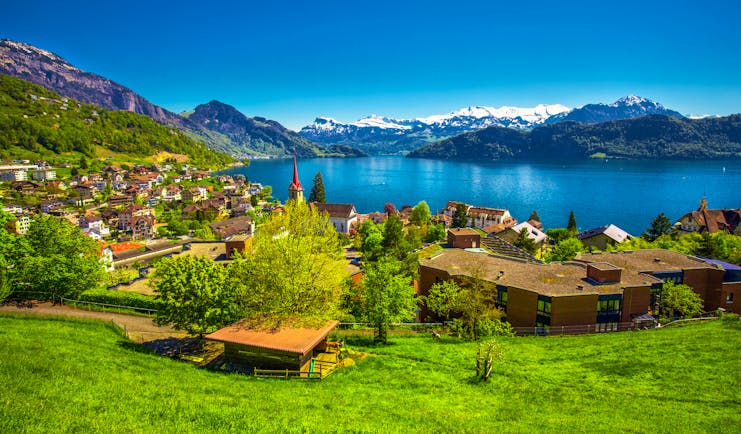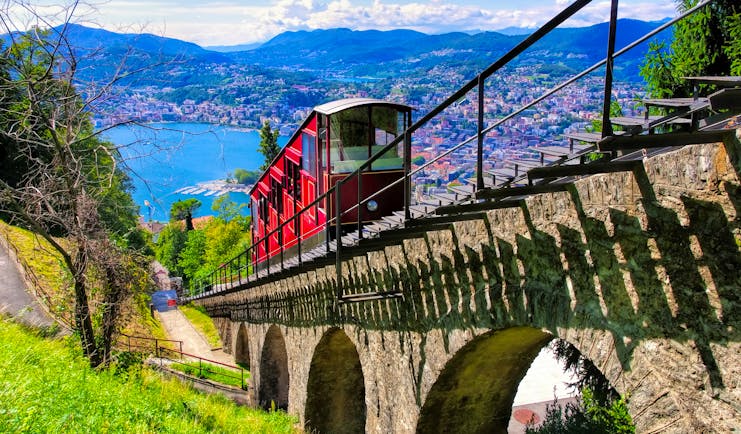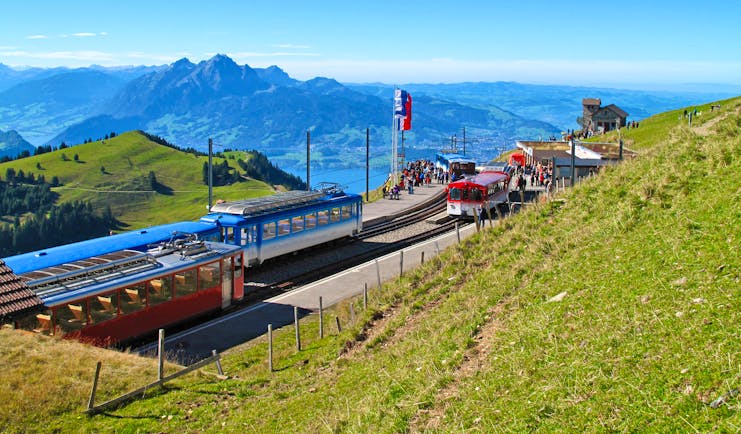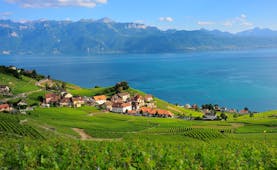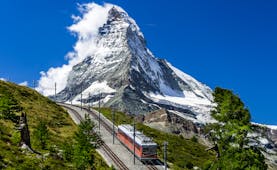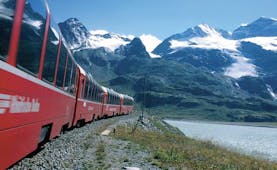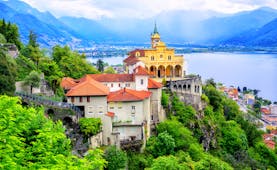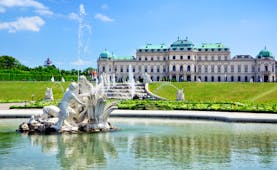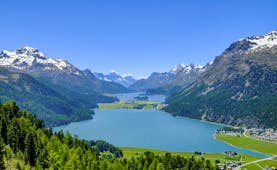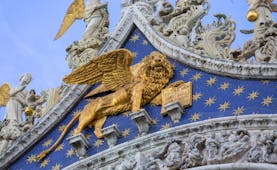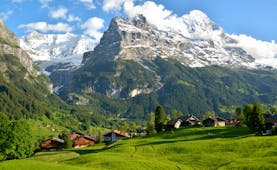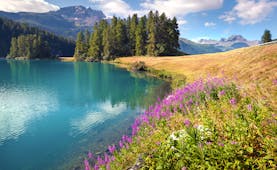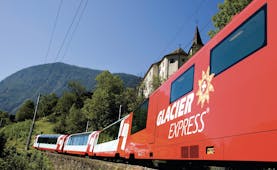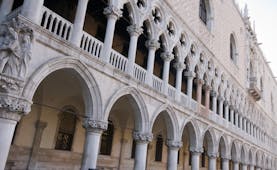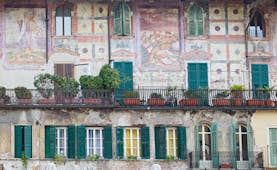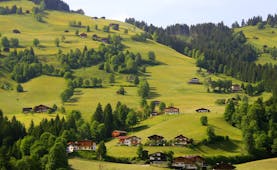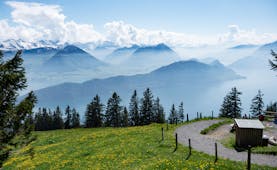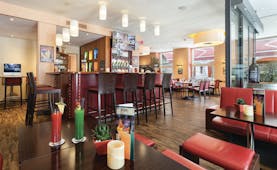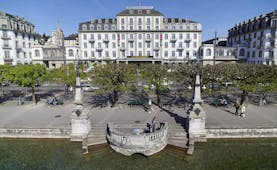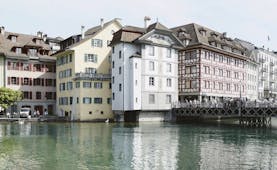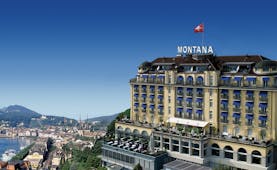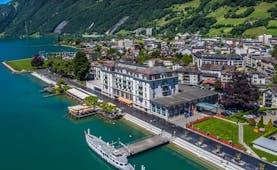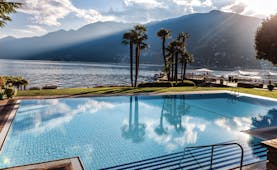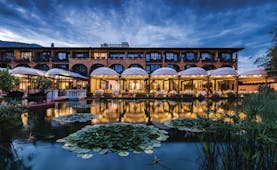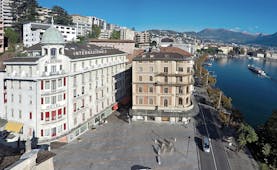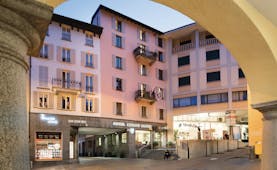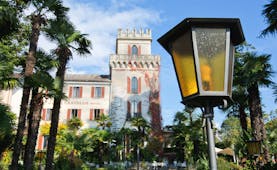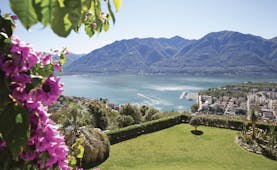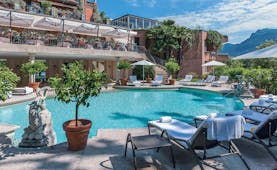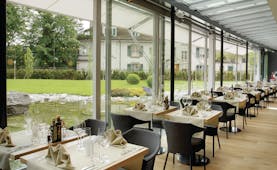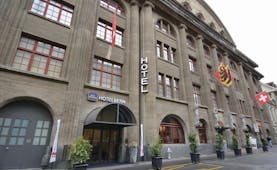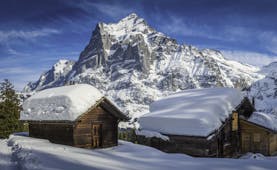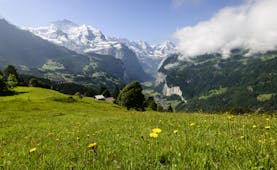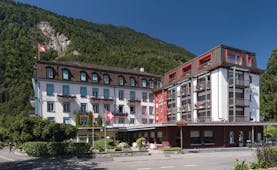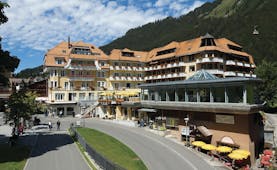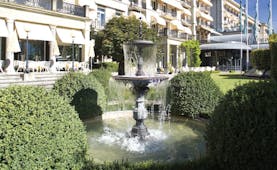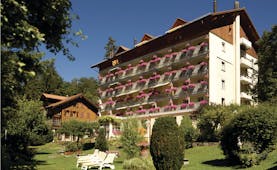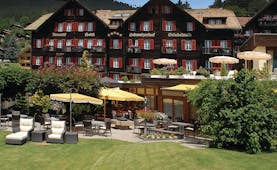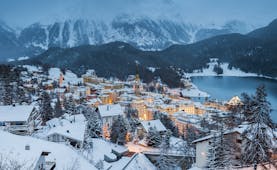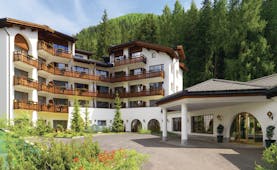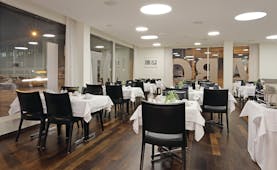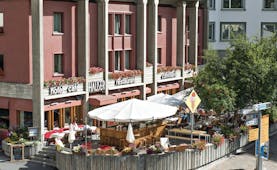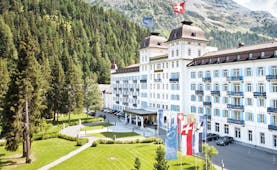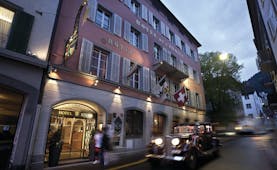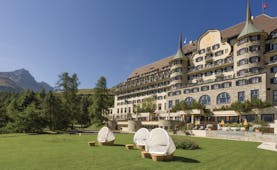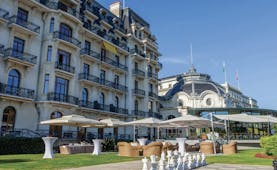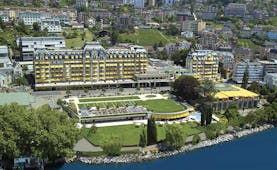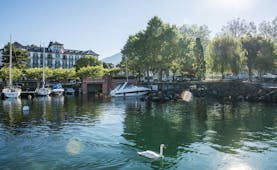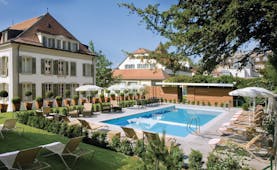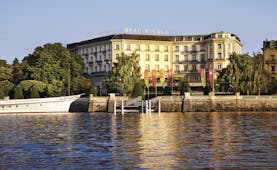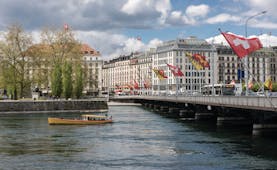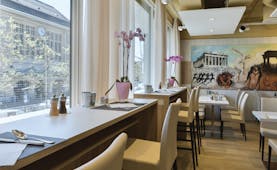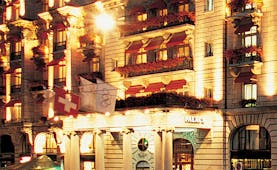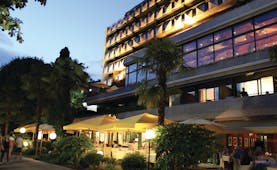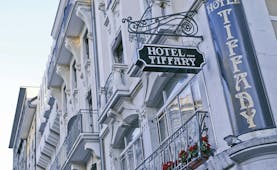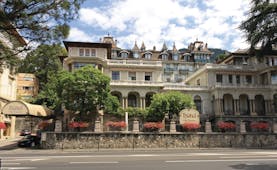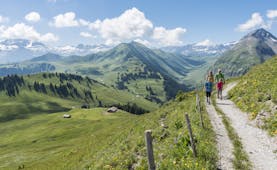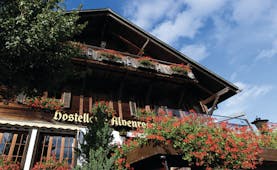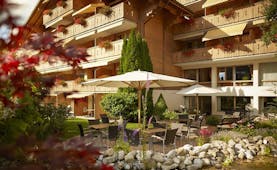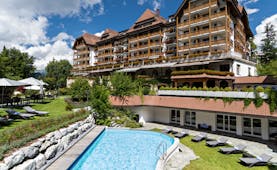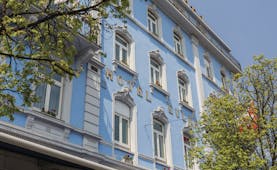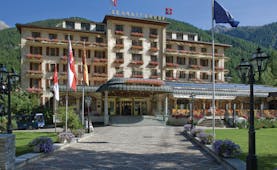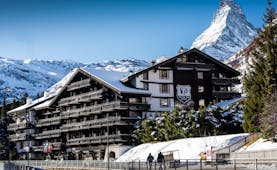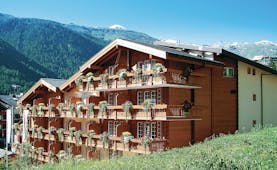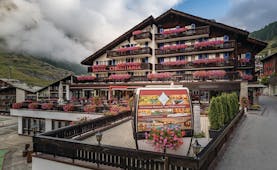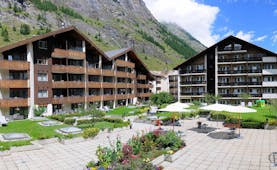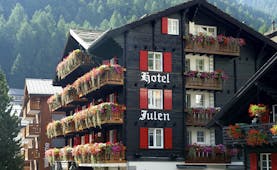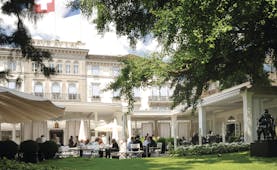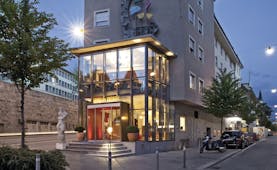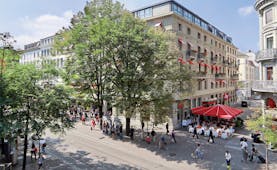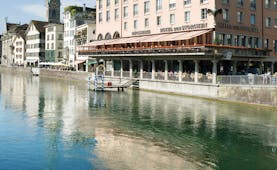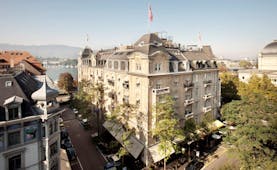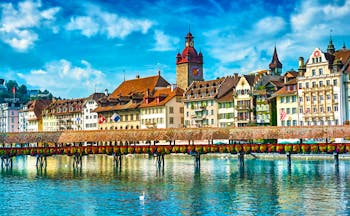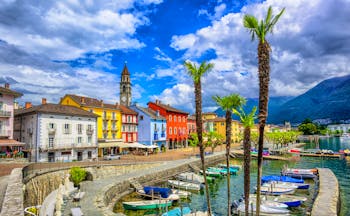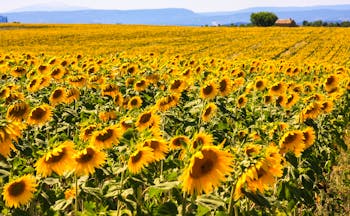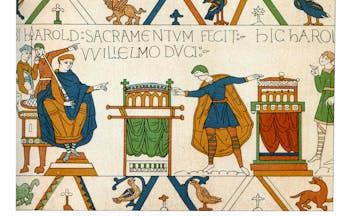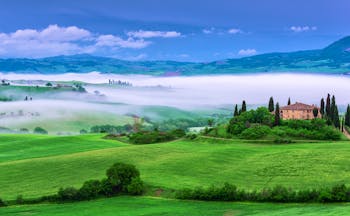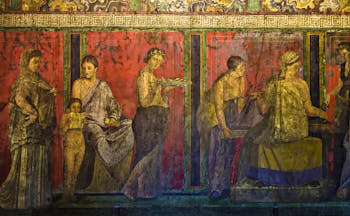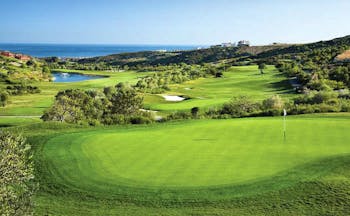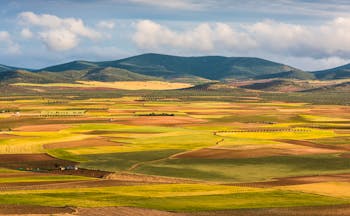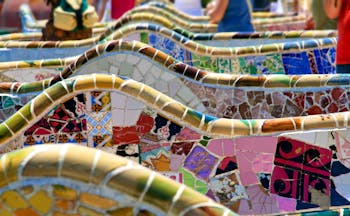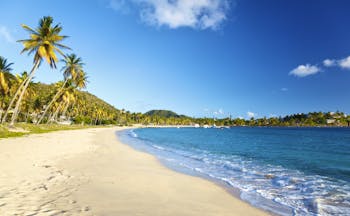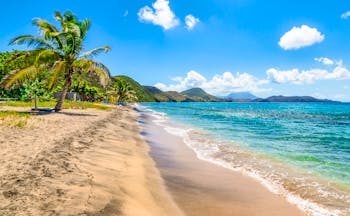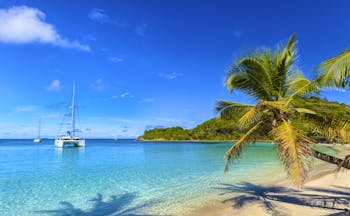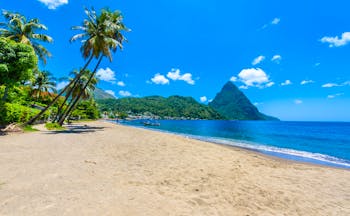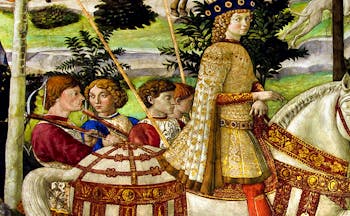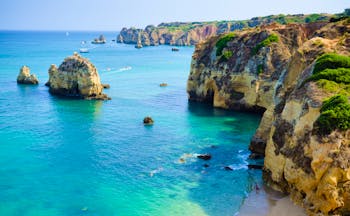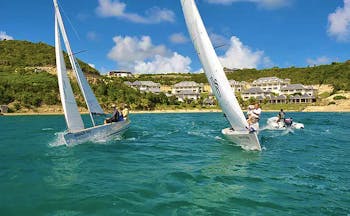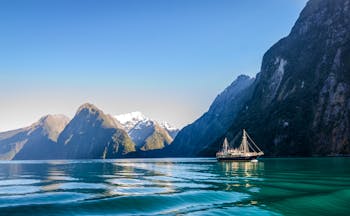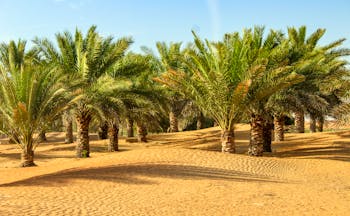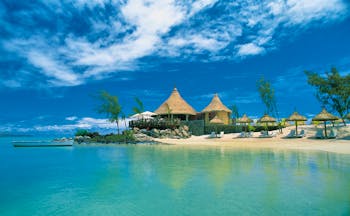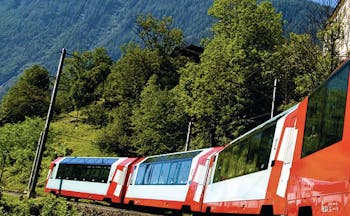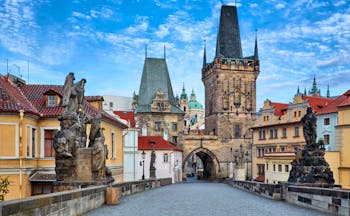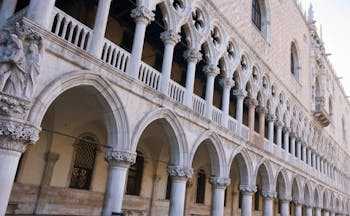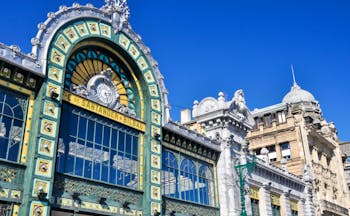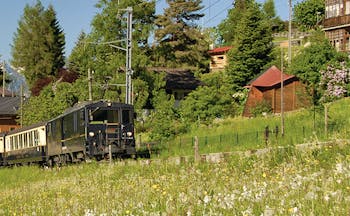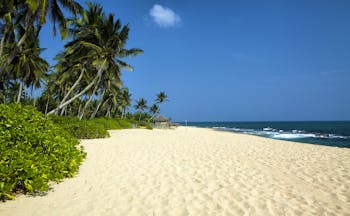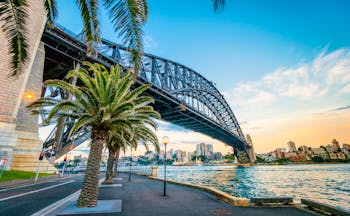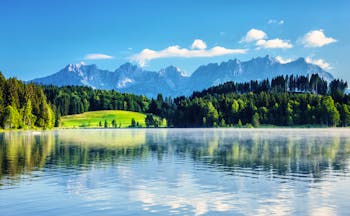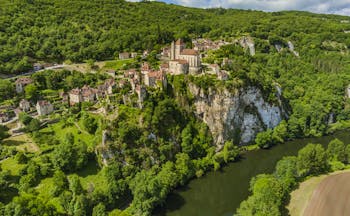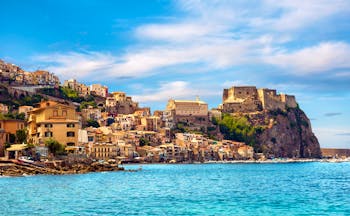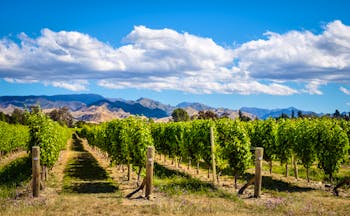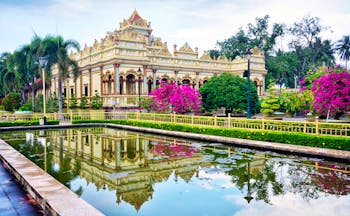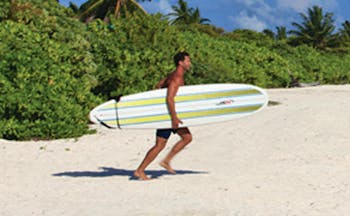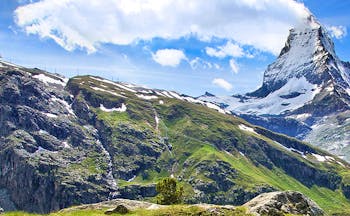Luxury Swiss iconic rail holiday with the Gotthard Panorama Express
This 5-night rail touring holiday begins with a three-night stay in Lucerne, the City of Lights, before boarding the Gotthard Panorama Express on your fourth day. The route of the Gotthard Panorama Express takes you first zig-zagging across Lake Lucerne in your choice of a steamboat or salon motorboat. Pass the iconic locations mentioned in Schiller’s poem, including the Rutli Meadows and Tell’s Chapel at Sisikon. When you reach Fluelen on the southern-most shore of the lake, disembark and board the train heading to Locarno. The journey south towards the Italian-speaking Ticino is lined with snow-capped peaks, interspersed with dramatic valleys, and broken up by a number of historic, picturesque towns. When you reach Bellinzona, change trains for Lugano, where you will spend two nights before taking a train north to Zurich for a return flight or train. You could return from Milan if you prefer.
Highlights
Lucerne • Boat trip on Lake Lucerne • Lake Lucerne • Brunnen • Gotthard Panorama Express • Rutli • Fluelen • Goschenen • Bellinzona • Lugano • Locarno
Day by day
On your first day, fly to Zurich and then take a train for the short journey south to Lucerne, where you will spend the first 3 nights of your rail holiday. You can also travel by train from London to Lucerne, changing in Paris and Basel usually. You have the rest of the evening to explore.
You have two full days to explore both Lucerne and the surrounds. The so-called City of Light is a bubble of cosmopolitan atmosphere, as well as a place of rich, historic significance. Wander down the pretty streets, taking in the individuality of the boutique shops and quaint cafes, or venture out into the surrounding landscape, visiting the Titlis Glacier, the Alpine meadows, and appreciating the views over the 13 nearby lakes, Swiss Mittelland, and the German and French borders from the Rigi Mountain. The Pilatus Mountain affords climbers and hikers views across more than 70 Alpine peaks, and is steeped in legends of dragons, giants, and royal graveyards. On your second day in Lucerne, perhaps take advantage of the two cog railways, from Vitznau and Goldau, and the panoramic cable car trip from Weggis as relaxing ways to take in the scenery. A highlight of your stay in Lucerne will be walking along the Chapel Bridge and seeing the Water Tower, though the river itself has much more to offer. We would encourage using your time in Lucerne as an opportunity to visit many more of the towns and villages on the northern shore of the lake.
From Lucerne, board the boat and begin your trip across the length of Lake Lucerne. The first stop on this lake cruise is in Hertenstein, a small collection of houses and a single eponymous hotel that cluster around the shores of a green, forested peninsula. Slightly further east along the northern shore of the lake is Weggis, the steamboat’s second stop. Here, the white-fronted houses climb the gently sloping lake shores from just a few metres from the water’s edge. The typically and idyllically Swiss feel of the town is completed by the distinctive red spire of the town’s small church. Following the curve of the lakeside, the boat takes you to the edge of the Canton of Lucerne, to Vitznau. Crowned by a chateau-esque waterside hotel, this tiny port village welcomes visitors with a cog railway and a Roman Catholic Church with an unusual clock tower. Then, the boat will take you through the narrow neck of Lake Lucerne, and across to the southern shore and Beckenried. Another small port town, Beckenried is adorned with cable cars, small lakeside beaches, and good access to the ski slopes the area is so famous for. Travel back northwards to Central’s Switzerland’s Riviera, Gersau, for the next stop, at the base of the Rigi Mountain. Surrounded by hiking routes, due to the self-contained shape of the hollow in which it sits, Gersau is an idyllic summer destination. The next stop is in Treib, a small community consisting almost entirely of a dock and a unique chalet characterised by its yellow and black striped shutters. The hillside is laced with zig-zagging roads and railway tracks. In contrast with this quiet spot, Brunnen is a bustling town, with tall townhouses that sit right on the waterfront, each with traditional brown roofs and large dormer windows that look out across the Alpine panoramas. It is also possible to join the Gotthard Panorama Express at Brunnen, due to easy access to the town via the valley. After Brunnen, you will come to Rutli, the first site that holds particular reference to the legend of Wilhelm Tell. The Rutli Meadows are the setting for Friedrich Schiller’s story of Wilhelm Tell, and were also where the four cantons swore their Oath of Eternal Alliance in 1291 and thus founded Switzerland. Across the lake, the steamboat will then stop in Sisikon, where Tell’s Chapel stands on the water’s edge. It is said that it was here that Tell jumped from the bailiff’s boat before kicking it back into the storm to aid his escape. The chapel itself is intricately decorated with four frescoes depicting iconic moments from the legend. The salon motorboat, however, rather than docking at Sisikon, will continue on to Bauen, reputedly one of Switzerland’s most romantic villages. From Sisikon, the steamboat moves on to Fluelen, where passengers transfer to the Wilhelm Express train. The salon motorboat, however, stops off in Isleten-Isenthal, the entrance to a municipality that is sparsely populated by traditional chalets, and is dotted with small pools, lakes, and smooth rolling hills. Board the train to Locarno in Fluelen to begin the ‘Express’ part of your journey. If you have time before your connection, wander along the rocky pathway that separates the harbour from the lake waters; this is perhaps the best place to take in the sublime panoramas of the fjord-like Urner Lake, as well as the chalets and grand houses of Fluelen that stretch out along the shore, skirting the steep slopes of the mountains and punctuated by the tower of the church. From Fluelen, the railway track runs along the Reuss River, as the landscape opens out onto a wide, flat plain, surrounded by jagged mountains that rise abruptly from the verdant ground. The train stops in Erstfeld, a modest group of houses, shops, and a church. After a longer stretch, the terrain becomes more typically Alpine, as the tracks gain altitude and the mountains close in on either side. Chocolate box villages dot the hillsides, linked by winding tracks. Solitary houses perch on top of jutting rocks and the views become even more rurally picturesque. As you pass through Wassen, notice the hilltop Wassen Church in the Urner Oberland, visible at three different points as you navigate the Gotthard loop tunnels. A complex network of roads and railway tracks marks Goschenen out as a prominent junction in the area; routes weave back on themselves and viaducts and tunnels allow the train to cross and re-cross the Reuss as it crashes into the smooth rocks that mark its course. The Gotthard Panorama Express now takes you on to the next stop at Airolo, through the Gotthard Strassentunnel. Immediately on your right as you emerge are the deep blue waters of the River Ticino, caught in a pool before a small dam. The train continues to follow the river here, passing intermittently through the outskirts of the mountainside forest. From Airolo to Biasca, the train passes through the Leventina district, which is a prominent transit axis from the Gotthard to the South. Waterfalls, winding streams, and historic chalets are hidden between the rocks, forests, and mountains. Next, stop in Faido, where the architecture has an Italianate twist. The River Ticino is met by the Cascata Piumogna before it resumes its turbulent path along the valley. The Express then passes through Biasca, a larger, but sparser town that has stretched to fill the hollow where two valleys meet. Then, the train stops in Bellinzona, Switzerland’s most Italianate town and capital of Ticino. Here, the ramparts of the central castle, perched on a rocky bluff, run alongside vineyards. Each detail of this monument has been carefully maintained, with lush grass carpeting the fortified castle wall walkways. Bellinzona is home to 3 of Switzerland’s best-preserved medieval castles, which come together to make up a UNESCO World Heritage Site. The route from Bellinzona to Lugano takes you first to the small, flat municipality of Giubiasco, just outside Bellinzona. Then, continue on to Rivera-Bironico, which is home to Switzerland’s most modern spa, the Tamaro Splash and Spa. The journey then takes you past Monte Tamaro, a 1962m peak situated on the land between Lake Maggiore and Lugano that is famous for the Santa Maria degli Angeli Church, designed by Mario Botta, and the ridge hike leading up to it from Monte Lema. Mezzovico sits beside Monte Tamaro, a commercial town with the added charm of a picturesque, isolated stone church. Pass through Torricella-Taverne on your way to Lamone-Cadempino, the penultimate stop on your tour, watching as the rural communities become grander and more urban. Arrive in Lugano and disembark for a 2-night stay at your choice of luxury hotel.
Use your time in Lugano to explore this cultural lakeside town, which is quintessential of the Ticino region. Lugano’s Old Town will be one of the highlights of your stay here, with its relaxed café culture influenced by both the Italian border and the prominent Swiss towns to the north. Pay a visit to the Cathedral of Saint Lawrence, which sits at the top of the gently stepped Via Cattedrale. This Roman Catholic cathedral was founded in the Middle Ages but was drastically rebuilt in the late 15th century. Its tower still rises high above Lugano, crowned by a distinctive green dome. For a further, more rounded, insight into Swiss cultural history, visit the waterside pink-fronted Museum of Cultures. Lake Lugano is perfect for a final sweeping boat trip, or for sampling the local water sports. The peak of nearby Monte Bre can be reached by funicular railway from Casserate, from where you can take in the sublime views, seek out the forested beauty spots, and embark on a hiking trail. San Salvatore can also be reached by funicular railway from Lugano, and offers an alternative, but no less stunning, perspective.
On your final day you return to Zurich by train for a flight back to the UK, or perhaps have an overnight in Zurich before continuing to London by train the next day. It is also possible to take a train to Milan for a flight back to the UK or perhaps to extend the holiday on the Italian Lakes.
I wanted to thank you for organising such a great trip - we have absolutely loved it. Really it couldn’t have all gone better - thank you for organising it so perfectly for us.Mrs C, June 2024
Holiday price guide From £1,960 per person based on two people sharing a double room and including for second class rail travel. First class supplement from £650 per person.
Holiday Code CHBR06
Call us on 01392 441245
Luxury Swiss iconic rail holiday with the Gotthard Panorama Express
On your first day, fly to Zurich and then take a train for the short journey south to Lucerne, where you will spend the first 3 nights of your rail holiday. You can also travel by train from London to Lucerne, changing in Paris and Basel usually. You have the rest of the evening to explore.
You have two full days to explore both Lucerne and the surrounds. The so-called City of Light is a bubble of cosmopolitan atmosphere, as well as a place of rich, historic significance. Wander down the pretty streets, taking in the individuality of the boutique shops and quaint cafes, or venture out into the surrounding landscape, visiting the Titlis Glacier, the Alpine meadows, and appreciating the views over the 13 nearby lakes, Swiss Mittelland, and the German and French borders from the Rigi Mountain. The Pilatus Mountain affords climbers and hikers views across more than 70 Alpine peaks, and is steeped in legends of dragons, giants, and royal graveyards. On your second day in Lucerne, perhaps take advantage of the two cog railways, from Vitznau and Goldau, and the panoramic cable car trip from Weggis as relaxing ways to take in the scenery. A highlight of your stay in Lucerne will be walking along the Chapel Bridge and seeing the Water Tower, though the river itself has much more to offer. We would encourage using your time in Lucerne as an opportunity to visit many more of the towns and villages on the northern shore of the lake.
From Lucerne, board the boat and begin your trip across the length of Lake Lucerne. The first stop on this lake cruise is in Hertenstein, a small collection of houses and a single eponymous hotel that cluster around the shores of a green, forested peninsula. Slightly further east along the northern shore of the lake is Weggis, the steamboat’s second stop. Here, the white-fronted houses climb the gently sloping lake shores from just a few metres from the water’s edge. The typically and idyllically Swiss feel of the town is completed by the distinctive red spire of the town’s small church. Following the curve of the lakeside, the boat takes you to the edge of the Canton of Lucerne, to Vitznau. Crowned by a chateau-esque waterside hotel, this tiny port village welcomes visitors with a cog railway and a Roman Catholic Church with an unusual clock tower. Then, the boat will take you through the narrow neck of Lake Lucerne, and across to the southern shore and Beckenried. Another small port town, Beckenried is adorned with cable cars, small lakeside beaches, and good access to the ski slopes the area is so famous for. Travel back northwards to Central’s Switzerland’s Riviera, Gersau, for the next stop, at the base of the Rigi Mountain. Surrounded by hiking routes, due to the self-contained shape of the hollow in which it sits, Gersau is an idyllic summer destination. The next stop is in Treib, a small community consisting almost entirely of a dock and a unique chalet characterised by its yellow and black striped shutters. The hillside is laced with zig-zagging roads and railway tracks. In contrast with this quiet spot, Brunnen is a bustling town, with tall townhouses that sit right on the waterfront, each with traditional brown roofs and large dormer windows that look out across the Alpine panoramas. It is also possible to join the Gotthard Panorama Express at Brunnen, due to easy access to the town via the valley. After Brunnen, you will come to Rutli, the first site that holds particular reference to the legend of Wilhelm Tell. The Rutli Meadows are the setting for Friedrich Schiller’s story of Wilhelm Tell, and were also where the four cantons swore their Oath of Eternal Alliance in 1291 and thus founded Switzerland. Across the lake, the steamboat will then stop in Sisikon, where Tell’s Chapel stands on the water’s edge. It is said that it was here that Tell jumped from the bailiff’s boat before kicking it back into the storm to aid his escape. The chapel itself is intricately decorated with four frescoes depicting iconic moments from the legend. The salon motorboat, however, rather than docking at Sisikon, will continue on to Bauen, reputedly one of Switzerland’s most romantic villages. From Sisikon, the steamboat moves on to Fluelen, where passengers transfer to the Wilhelm Express train. The salon motorboat, however, stops off in Isleten-Isenthal, the entrance to a municipality that is sparsely populated by traditional chalets, and is dotted with small pools, lakes, and smooth rolling hills. Board the train to Locarno in Fluelen to begin the ‘Express’ part of your journey. If you have time before your connection, wander along the rocky pathway that separates the harbour from the lake waters; this is perhaps the best place to take in the sublime panoramas of the fjord-like Urner Lake, as well as the chalets and grand houses of Fluelen that stretch out along the shore, skirting the steep slopes of the mountains and punctuated by the tower of the church. From Fluelen, the railway track runs along the Reuss River, as the landscape opens out onto a wide, flat plain, surrounded by jagged mountains that rise abruptly from the verdant ground. The train stops in Erstfeld, a modest group of houses, shops, and a church. After a longer stretch, the terrain becomes more typically Alpine, as the tracks gain altitude and the mountains close in on either side. Chocolate box villages dot the hillsides, linked by winding tracks. Solitary houses perch on top of jutting rocks and the views become even more rurally picturesque. As you pass through Wassen, notice the hilltop Wassen Church in the Urner Oberland, visible at three different points as you navigate the Gotthard loop tunnels. A complex network of roads and railway tracks marks Goschenen out as a prominent junction in the area; routes weave back on themselves and viaducts and tunnels allow the train to cross and re-cross the Reuss as it crashes into the smooth rocks that mark its course. The Gotthard Panorama Express now takes you on to the next stop at Airolo, through the Gotthard Strassentunnel. Immediately on your right as you emerge are the deep blue waters of the River Ticino, caught in a pool before a small dam. The train continues to follow the river here, passing intermittently through the outskirts of the mountainside forest. From Airolo to Biasca, the train passes through the Leventina district, which is a prominent transit axis from the Gotthard to the South. Waterfalls, winding streams, and historic chalets are hidden between the rocks, forests, and mountains. Next, stop in Faido, where the architecture has an Italianate twist. The River Ticino is met by the Cascata Piumogna before it resumes its turbulent path along the valley. The Express then passes through Biasca, a larger, but sparser town that has stretched to fill the hollow where two valleys meet. Then, the train stops in Bellinzona, Switzerland’s most Italianate town and capital of Ticino. Here, the ramparts of the central castle, perched on a rocky bluff, run alongside vineyards. Each detail of this monument has been carefully maintained, with lush grass carpeting the fortified castle wall walkways. Bellinzona is home to 3 of Switzerland’s best-preserved medieval castles, which come together to make up a UNESCO World Heritage Site. The route from Bellinzona to Lugano takes you first to the small, flat municipality of Giubiasco, just outside Bellinzona. Then, continue on to Rivera-Bironico, which is home to Switzerland’s most modern spa, the Tamaro Splash and Spa. The journey then takes you past Monte Tamaro, a 1962m peak situated on the land between Lake Maggiore and Lugano that is famous for the Santa Maria degli Angeli Church, designed by Mario Botta, and the ridge hike leading up to it from Monte Lema. Mezzovico sits beside Monte Tamaro, a commercial town with the added charm of a picturesque, isolated stone church. Pass through Torricella-Taverne on your way to Lamone-Cadempino, the penultimate stop on your tour, watching as the rural communities become grander and more urban. Arrive in Lugano and disembark for a 2-night stay at your choice of luxury hotel.
Use your time in Lugano to explore this cultural lakeside town, which is quintessential of the Ticino region. Lugano’s Old Town will be one of the highlights of your stay here, with its relaxed café culture influenced by both the Italian border and the prominent Swiss towns to the north. Pay a visit to the Cathedral of Saint Lawrence, which sits at the top of the gently stepped Via Cattedrale. This Roman Catholic cathedral was founded in the Middle Ages but was drastically rebuilt in the late 15th century. Its tower still rises high above Lugano, crowned by a distinctive green dome. For a further, more rounded, insight into Swiss cultural history, visit the waterside pink-fronted Museum of Cultures. Lake Lugano is perfect for a final sweeping boat trip, or for sampling the local water sports. The peak of nearby Monte Bre can be reached by funicular railway from Casserate, from where you can take in the sublime views, seek out the forested beauty spots, and embark on a hiking trail. San Salvatore can also be reached by funicular railway from Lugano, and offers an alternative, but no less stunning, perspective.
On your final day you return to Zurich by train for a flight back to the UK, or perhaps have an overnight in Zurich before continuing to London by train the next day. It is also possible to take a train to Milan for a flight back to the UK or perhaps to extend the holiday on the Italian Lakes.
I wanted to thank you for organising such a great trip - we have absolutely loved it. Really it couldn’t have all gone better - thank you for organising it so perfectly for us.Mrs C, June 2024
Holiday price guide From £1,960 per person based on two people sharing a double room and including for second class rail travel. First class supplement from £650 per person.
Holiday Code CHBR06
Our prices include
● Flights from UK to Zurich and back from Milan OR rail travel London to Switzerland and back via Paris (first class can be booked at a supplement)
● 4-day Swiss rail flex pass (first class can be booked at a supplement)
● Travel on the Gotthard Panorama with seat reservation on the train
● 3 nights’ bed and breakfast in a Classic double room at the Hotel Wilden Mann, Lucerne
● 2 nights’ bed and breakfast in a Quality double room at the Hotel Lugano Dante, Lugano
● Concierge service and Expressions Holidays regional helpful hints
Our prices do not include
● Early check-in or late check-out at any hotels (although we can arrange this on request at additional cost)
● Any other services not mentioned above, such as transfers and meals except breakfast at hotels
● Personal holiday insurance. This is essential and cover should be in place from when you book the holiday.
● Local tourist tax, usually between Swiss Francs 1 and 3 per person per night, and payable locally to the hotel
● Transfers in Paris (applicable if travelling to Switzerland by train)
● Transfers in Switzerland station to hotel unless offered by your hotel
● Transfer from Milan station to Linate airport (if required)
● Optional extra nights in Zurich, Lucerne, Lugano, Geneva, or Bern
Call us on 01392 441245
Luxury Swiss iconic rail holiday with the Gotthard Panorama Express
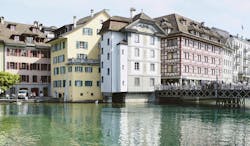
Hotel Wilden Mann is a 4-star boutique hotel in an excellent central location. With gourmet cuisine and stylish, comfortable accommodation, the 500 year-old hotel balances its historic and old-world style with elegance and modern facilities.
Classic double room
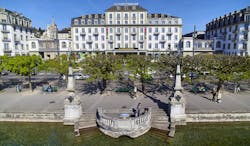
The Hotel Schweizerhof Luzern is a grand 5-star hotel with an imposing history situated on the shores of Lake Lucerne.
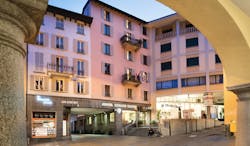
Hotel Lugano Dante is a comfortable, 4-star hotel in the centre of Lugano. This hotel serves as a comfortable and welcoming base from which to explore the town, lake and surrounding rural area.
Double room
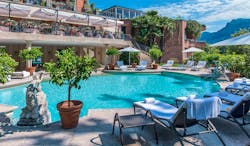
The Villa Principe Leopoldo in Lugano is an elegant, historic hotel set on a hill above the city of Lugano. 37 suites, restaurant, two outdoor pools, winter garden, piano bar, spa.
Deluxe junior suite with balcony
I wanted to thank you for organising such a great trip - we have absolutely loved it. Really it couldn’t have all gone better - thank you for organising it so perfectly for us.Mrs C, June 2024
Holiday price guide From £1,960 per person based on two people sharing a double room and including for second class rail travel. First class supplement from £650 per person.
Holiday Code CHBR06
Call us on 01392 441245
Luxury Swiss iconic rail holiday with the Gotthard Panorama Express
About Lake Lucerne
An Expressions tailor-made holiday to Lake Lucerne allows travellers to be immersed in history, folklore, and bustling modern culture. Lake Lucerne brings together everything that makes Switzerland in summer so special. The city of Lucerne itself is one of the most beautiful cities in the world. White-walled, tiled-roof townhouses crowd together on the water's edge; bridges on stilts take visitors from one side of the river to the other; and the high original rampart wall is visible in the distance. Outside the city, you are free to enjoy the Alpine panoramas from a boat, or from one of the hiking trails that score the mountainsides. Thrilling extreme sports can be enjoyed alongside serene rounds of golf in quilted green valleys, or hours can be whiled away in one of the smaller towns and villages around the lakeside. Further inland, you can uncover villages virtually untouched by commercial tourism that seem to be preserved in a bubble of authenticity. Any stay in the Lake Lucerne region will be one packed full of stunning views, nature excursions, and exhilarating hours on the mountainsides or on the water.
Highlights of Lake Lucerne
Begin your exploration of the Lake Lucerne Region with the famous city itself. To get your bearings, wander along the river or lakeside, stopping first at the Chapel Bridge, Lucerne's main landmark and the most photographed monument in Switzerland. This bridge gets its name from St Peter's Chapel, which stands nearby, and was built in the early 14th century, making it a true testament to its ingenious structure. The Water Tower that stands partway along the bridge once formed part of the city walls, and has served a number of functions, including that of an archive, prison, and torture chamber. Also part of the city's fortifications is the Spreuer Bridge, which, again, stretches across the Reuss, but with an unusual ochre design characterised by the small red turrets attached above the bridge's supports. The so-called ‘Water Spike,' which regulates the water level in the Reuss River, is recognised for being a truly unique sight, due to the specificities of its engineering. For more stunning, historical structures, visit the 17th century Jesuit Church, with its grand, regal Baroque façade, which was the first large sacral church to be built in Switzerland. High above the city is the Musegg Wall. Built in the late 14th century, the wall remains remarkably well preserved, as do the nine towers, of which three are open to the public. For a taste of traditional Swiss life, visit one of the historical squares hidden down the city streets and enjoy a light lunch or drink in one of the cafes. The Town Hall and Pfistern Guildhall, which is artfully painted, are situated on the Kornmarkt Square; the Hirschenplatz Square is named after an inn that dates back to medieval times; and the Weinmarkt Square is the site on which Lucerne swore its federal oath with Schwyz, Uri, and Unterwalden in the early 14th century.
Cultural highlights of Lake Lucerne
Lucerne is home to a variety of museums and galleries, including the KKL Luzern, the Rosengart Collection of works by Picasso and Klee, the Wagner Museum in Tribschen, and the most well-known of them all, the Swiss Museum of Transport. Once you have explored Lucerne's streets, restaurants, and shops, finish your tour with a visit to the Dying Lion of Lucerne. Commemorating the deaths of the Swiss mercenaries at the attack on the Tuileries at the end of the 18th century, this monument is one of the most moving in Europe. Follow the northern shore of the lake to the picturesque villages of Weggis and Vitznau. Weggis is recognisable from the water by the red-topped church spire at the village's highest point. The scattered houses in both are surrounded by green lawns, clusters of evergreen trees, and gently rising slopes. The Wilhelm Tell Express will take you by boat from Lucerne across the river to Fluelen, passing the iconic spots that feature in the legend of Wilhelm Tell, the best known folk character in Switzerland and the Swiss National Hero of Liberty. The meadows in Rutli, for example, are the setting of Friedrich Schiller's recounting of Tell's tale, and Tell's Chapel in Sisikon is built upon Tell's Slab, where he famously jumped from the bailiff's boat before pushing them back into the storm. Further inland, in the neighbouring cantons that claim sections of Lake Lucerne's shores, are several picturesque towns and villages with their own individual character. The town of Schwyz, in the canton of the same name, provides both a valuable connection with the cities and towns to the east of Lake Lucerne and an equally valuable insight into the traditions and atmospheres of small towns that have retained much of their historical air. The most popular and interesting part of this town, which is mainly characterised by its peaceful streets of chalet-style buildings, is the Hauptplatz. Here, you can admire the painted façade of the Town Hall while enjoying some food at the restaurant of the Hotel Wysses Rossli. Those looking to explore the landscape on foot or by cable car should head towards the two main peaks of the Lucerne area: Pilatus and Rigi. The former was once reputedly the home of a dragon and is now believed to be the final resting place of Pontius Pilatus, but most remarkable are the views across 73 Alpine peaks that can be appreciated from the top. Rigi is known as Queen of the Mountains, from the summit of which you can see 13 lakes, the entire Swiss Mittelland, and the borders into Germany and France. A cable car up to Rigi can be taken from Weggis. To enjoy the scenery by rail, take the funicular railway from Stoos to Fronalpstock or vice versa, the track of which is the world's steepest. Once on the mountainsides, you are at your leisure to embark on cycling tours and hiking tours to unveil the waterfalls and mountain streams, to take a once-in-a-lifetime skydiving or paragliding trip, or to take your time with a round of golf. The range of places and activities that surround Lake Lucerne is given its diversity by the stunning landscape, and by the coming together of so many cantons, each with their own unique culture. We would recommend staying long enough to try a little of everything to truly make the most of this fantastic and inspiring region.
Festivals in Lake Lucerne
Lucerne prides itself on being a city of festivals, a title that it lives up to through its blend of music, food, and theatrical celebrations. The biggest of these is without a doubt the Lucerne Carnival. Beginning on Fat Thursday before Lent begins, the carnival features three massive parades with masks, costumes, bonfires, and displays by the various societies in the area. Music festivals in Lucerne also include the World Band Festival at the end of September, the Lucerne Blues Festival at the beginning of November, the Lucerne Festival at the Piano in mid to late November, the two Lucerne Festivals (at Easter and in summer) which focus on classical music, and the Blue Balls music and art festival in late July. Sports enthusiasts might want to plan their visit in time with the Lucerne Regatta, on the 7th to 9th July 2017, and the Athletics Meeting, also in July.
Gastronomy in Lake Lucerne
The food around Lake Lucerne, like its history, is made diverse by the numerous cantons. Visitors can enjoy high-class gourmet food in stylish modern restaurants, or can enjoy traditional delicacies in smaller, family-run establishments. One example of a popular local dish is the Lozarner Churgelipastete, which comprises of veal and mushrooms cooked inside a puff-pastry casing. Those with a sweet tooth might wish to try the pear bread. To try some Swiss Alpine cheese, we would recommend ordering either the raclette or the fondue, as these are possibly the most typically Swiss dishes available. Finish off your culinary tour of Lucerne with some of the famous Swiss chocolate made by a local chocolatier.
Call us on 01392 441245
Luxury Swiss iconic rail holiday with the Gotthard Panorama Express
About Ticino
An Expressions tailor-made holiday to Ticino allows travellers to witness the sheer diversity of Switzerland as a country. Hailed as having a Mediterranean climate, Ticino is Switzerland's most southerly region. Italianate towns, influenced by the proximity of the Italian border, provide a wholly different culture and atmosphere to the Bernese Oberland, the Saanenland, and other central and northern regions. A smattering of small lakes mark the upper boundary of Ticino, but it is Lake Maggiore and Lake Lugano that dominate the south, prompting many of the long, straight valleys that lead into Italy. The River Ticino winds its way down from its source on the Ticino border, meeting dams, lakes, and trickling and tumbling waterfalls on its way. Palm trees line the lakesides, medieval Italian castles form the centre-points of towns, and colourful, higgledy-piggledy houses look out across the water or from their tiered position on the steep mountainside. Communities here seem to effortlessly blend the feel of southern coastal towns with the rural authenticity of the mountain villages of central Switzerland.
Highlights of Ticino
Two of the main cities in Ticino lie quite close together in the south of the region: Locarno and Lugano. On the banks of Lake Maggiore, Locarno is rich with cultural treasure. Visit the 17th century Church of St Anthony, the 16th century Church of San Francesco, the mid-17th century New Church, or the late 15th century Sanctuary of the Madonna del Sasso to begin your tour of Locarno's beautiful and historic sites. Perhaps most noteworthy, however, is the Visconti Castle, in which there is a permanent exhibition of Roman glass. On Thursdays a market is held in the centre of the town, which always makes for an excellent place to enjoy Locarno at its liveliest, as well as to pick up a few delicacies. Venture outside Locarno to climb the Cadada Cimetta, from the top of which you can see both the Valais High Alps and Lake Maggiore, the highest and lowest points in Switzerland. Follow the paths of the Magic Valley or the Verzasca Valley to witness the turquoise-green, crystal-clear waters that flow there. For a more leisurely day out, enjoy a boat cruise on Lake Maggiore. As you leave Locarno and head west down the valley towards Italy, you will see the rocky gorges that prove so popular with cliff divers. Eerie tunnels and caverns have been carved out over time, providing ethereal little spots to stop off on your travels.
Cultural highlights of Ticino
East of Locarno is Bellinzona, a town remarkable in that it is the most Italianate town in Switzerland and capital of Ticino. The central medieval castle and its two neighbours are among Switzerland's best preserved, coming together to form a picturesque UNESCO World Heritage Site. The ramparts of the central castle run alongside the vineyards within, with lush grass carpeting the fortified walls. North of Locarno, you will come across Tegna, the site of some interesting prehistoric ruins. Continue along this route towards the Italian border on the Centovalli Express to discover the old wine press in the village of Cavigliano, the museum and cableway in Intragna, the cable car up to the solitary, traffic-free hamlet of Rasa from Verdasio, and finally, across the Italian border to Re, where the stunning, yet imposing, Sanctuary of the Madonna of the Blood stands on the very edge of a dramatic cliff. In eastern Ticino is Biasca, a town where a waterfall cascades down the mountainsides, under bridges and over rocks that have been smoothed by time. Towns and villages such as Airolo, Lavizzara, Acquarossa, Blenio, and Brione all offer alternative views on this beautiful region. Any visit to Ticino is incomplete without a few hours spent in Lugano. Famous for its eponymous lake, San Salvatore Mountain, and Monte Bre, Lugano is a quintessentially ‘Ticino’ town. Take the funicular railway from Casserate as high as possible up Monte Bre to witness the phenomenal panoramas and enjoy the traditional Swiss rail experience.
Festivals in Ticino
As with much of Switzerland, there is a high focus on dairy products in both the regional dishes and their self-identification. To appreciate Swiss dairy products in Ticino, head to Ambri Quinto in the Leventina Valley at the end of September to enjoy the Agriculture and Cheese Fair. The first weekend in October brings with it a celebration of autumn. In Lugano, this autumn festival focuses on local products, folkloric music, and small dramatic shows. In Ascona, the autumn festival celebrates the versatile chestnut, with jams, cakes, cheese dishes, and entertaining concerts. Ascona's unique carnival is celebrated on Mardi Gras on the lake promenade. In Muralto on the second Sunday of March there is a fish festival beside the water, involving a fishing contest, music, games, and food stalls. Beside the smooth rocks of Solduno, on St Joseph's Day in March, the streets are filled with the smell of the speciality Tortelli, a fritter whose recipe is strictly guarded.
Gastronomy in Ticino
The varied and delicious specialities of Ticino may very well be the highlight of your trip, influenced by hearty Swiss cuisine, as well as Italy's Mediterranean flavours. One particular feature of dining here are the ‘grotto' restaurants. Usually housed in picturesque stone farmhouses, with abundant flower boxes, shuttered windows, and vast terraces canopied by views on which customers eat fresh, home-cooked food. Popular so-called ‘slow foods' include farina bona flour, cicitt sausages, Zincarlin cheese and shortbread biscuits. At the heart of many dishes you may come across are polenta and Merlot wine, which can also be sampled at a local winery. Originally cooked in a large cauldron like porridge, polenta is now best served alongside braised beef. Before leaving Switzerland, ensure you sample some of the world-famous fondue.

